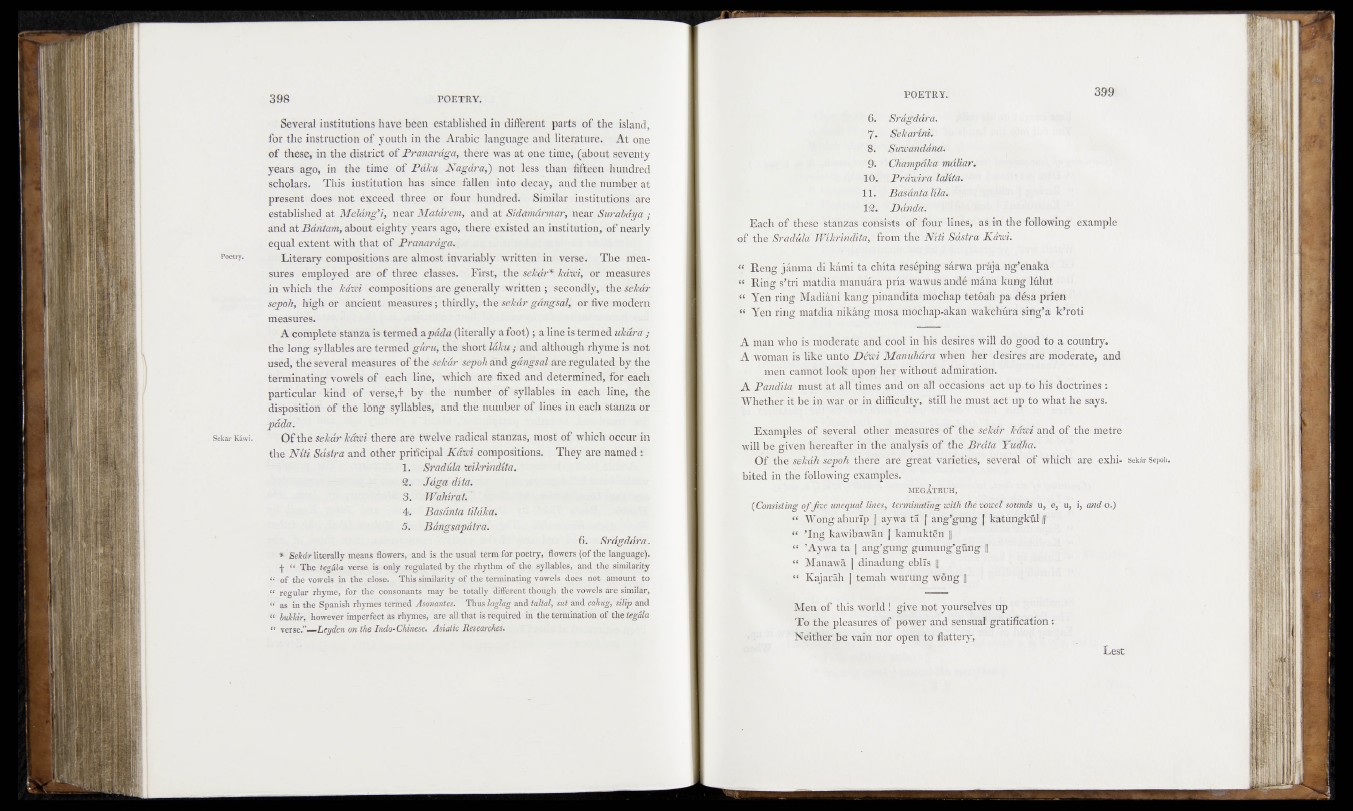
Several institutions have been established in different parts of the island,
for the instruction of youth in the Arabic language and literature. At'.one
of these, in the district of Pranaraga, there was at one time, (about seventy
years ago, in the time of Pdku Nagdra,) not less than fifteen hundred
scholars. This institution has since fallen into decay, and the number at
present does not exceed three or four hundred. Similar institutions are
established at Meldng’i, near Matdrem, and at Sidamdrmar, near Surabdya ;
and at Bdntam, about eighty years ago, there existed an institution, of nearly
equal extent with that of Pranardga.,
Literary compositions are almost invariably written in verse. The measures
employed are of three classes. First, the sekdr* kdwi, or measures
in which the kdwi compositions are generally written ; secondly, the sekdr
sepoh, high or ancient measures; thirdly, the sekdr gangsal, or five modern
measures.
A complete stanza is termed apada (literally afoot); a line is termed uk&ra ;
the long syllables are termed g&ru, the short Idfcu / and although rhyme is not
used, the several measures of the sekdr sepoh and gdngsal are regulated by the
terminating vowels of each line, which are fixed and determined, for .each
particular kind of verse,t by the number of syllables in each, line, the
disposition of the long syllables, and the number of lines in each stanza or
pada.
Of the sekdr kdwi there are twelve radical stanzas, most of which, occur in
the N iti Sdsira and other principal Kdwi compositions. They are named:
- 1. Sradula wikrindtia.
%. Jdga dita. g
B m Wahirat. "
4. Basdnta tildka.
5. Bangsapatra.
• 6. Srdgddra.
* SeJcdr literally means flowers, and is the usual term for poetry, flowers (of the language).
•j- “ The teg&Uk Verse is -only regulated by the rhythm of the. syllables, and the similarity
.“ ‘of the vowels in the close. This similarity of the terminating vowels does not amount to
“ regular rhyme, for the consonants may he, totally, different thoughthe vowels are similar,
“ as in the Spanish rhymes termed Asonantes. Thus laglag and taltal, sat and cahug, silip and
“ lukMr, however imperfect as rhymes, are all that is required in the termination of the teg&la
“ verse.”— on the Indo-Chinese. Asiatic Researches.
7'- S'ekarinL
8 . Suwandana.
! u3?p ‘^ Ghampdlm mdUart
1 0 . [PtdtyirM lolita.
11. Basdntalttul ^1?
^ ~'i
Each of'.fb^P staii’zas èchsist». of'-fönr” lines, a l in the faüoiwing' eXiHflt
of the Sradula Wikrinditaft&om the”Mfi Sdstra Kdwi.
Beng janma di kami ta chitä resêpïng sérwa praja ng’enaka -
** Bing s’tri xnafdia manuara pria wawus andé mäna kung Ifdttt -
« Yen ring Madiani kang pinandtta-mechap tetéah pa désa prfett
y Yen ring matdia nikang mosa''m’Öèhap-akan wafeehufd sing’a k’foti
A 'man who is 'moderate afld bó'ol in b il de'&rfès Will do gböd fq a country.
A‘wonaan is'Mè unto Uêwï Maflühdnt when hier! dësfres" arë tóocferate, and
.melnT caifti'öt Tóöfe npoff hefwithout admiration.
A Pandita must.‘at all times äfldröÄ aÏÏ o^caltoW'‘act up.tó'fiiS'aoctrines :
Whethenit be in war or in difficulty, still he must .act up to what he says.
Examples of several, other measures off the se'Mr kdwi'and of the metre
will be given hereafter1 iff'the afilüysfä of the Èrdta YükfCa. ’
' Of the sekdh sepoh thprePare great varieties, sevërsd. ‘ óf ■Wfriclr ana exhi- setór sepoh.
bited in the following examples.
MKG2,'riWilf ■ ^
{Consisting of$oe unequal litres, terminating with the wwet sounds' u , ë f u*. i, and o .)
“ Wang ahurïp j aywa ta f ang’gnng [ katurngkEil' jf
A ’Ing kawibawSn fkamnktérr
“ ’Aywa ta J ang’gung gumutigig|uhg”r “' ,
“ Manawä | dinadung eblïs [| y
** Kajaräh | temab wörttag W©ng[|' , I
Men of this world! give not yqufsefvés tip
To the pleasures! bf psower and sen&räf gfatificaction r
Neither be vain nor open to flattery,
Lest